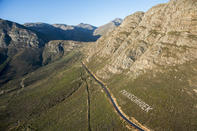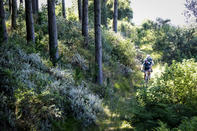From Olifants Pass to Franschhoek Pass
Franschhoek Pass was originally built along a course that migrating elephants had trampled into the slopes of the mountain over many centuries. It was noted by early governors, like Simon Van Der Stel, as a potential timber route to the interior, but it was simply too rugged and narrow to be practical.

The pass remained undeveloped for over 150 years. By 1818, however, the local farmers had succeeded in getting the British government to put some money towards building a pass over the mountains, and a contractor, S.J Cats, was appointed to construct a road. His attempts were rough and ready, and the pass was so steep that only a half-laden wagon could make the ascent. The original Cats’ Pad can still be walked as a hiking trail, and permits are available from the Tourism Bureau.
The pass remained undeveloped for over 150 years. By 1818, however, the local farmers had succeeded in getting the British government to put some money towards building a pass over the mountains, and a contractor, S.J Cats, was appointed to construct a road. His attempts were rough and ready, and the pass was so steep that only a half-laden wagon could make the ascent. The original Cats’ Pad can still be walked as a hiking trail, and permits are available from the Tourism Bureau.
Through Tree-lined Foothills

In 1822, the British governor Charles Somerset, appointed a commission to investigate the best route from Cape Town to the Overberg region. The committee, chaired by one Major Holloway of the Royal Engineers, found that Hottentots Holland Kloof (Sir Lowry’s Pass) was more direct, but Franschhoek would be much cheaper to build. As the British administration in South Africa was always keen on a penny or two, the Franschhoek Pass was duly opened in 1825.
The construction of the pass was supervised by Holloway, and he used some rowdy surplus soldiers stationed in Cape Town as an impromptu labour force. The Franschhoek Pass was the first engineered road pass in South Africa, and it remained the main route to the Overberg until Sir Lowry’s Pass over the Hottentots Holland Mountains opened in 1930. After the Sir Lowry’s route was built, traffic over the Franschhoek Pass declined and the road fell into disrepair until it was declared unsafe and closed in the 1920’s.
During the depression, a new pass was built as a poverty alleviation project, and this was upgraded in the 1950’s to become the road we follow today. The road begins by spooling up through the tree-lined foothills of the mountain face. As you rise, the view into the Franschhoek Valley deepens and the fields diminish to become red and green squares on an irregular chess board. Alongside the road, there are several large viewing areas where you can stop the car and gaze out over the near-sheer sides of the mountain, down to the small town below.
By David Fleminger Accommodation in Franschhoek will transport guests from busy city life into a world of beautiful natural scenery, charming architecture and ...
Accommodation in Franschhoek will transport guests from busy city life into a world of beautiful natural scenery, charming architecture and ... Franschhoek is a picturesque town that is gently nestled between towering mountains in the spectacular Cape Winelands and is renowned for it...
Franschhoek is a picturesque town that is gently nestled between towering mountains in the spectacular Cape Winelands and is renowned for it...